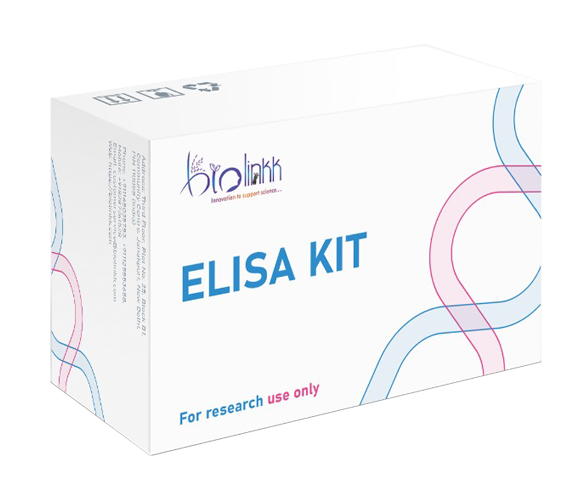Human Transforming Growth Factor Β1, TGFB1 ELISA Kit

Product Summary
• Size: 48T,96T
• Sensitivity: 5.11ng/L
• Detection range: 10-4000ng/L
• Reactive with: Human
Product Details
Product Specifications |
|
|---|---|
|
Full Product Name: |
Transforming Growth Factor beta1 |
|
Catalog No.: |
BL0134EH |
|
Size: |
48T,96T |
| Detaction Range: |
10-4000ng/L |
| Sensitivity: |
5.11ng/L |
| Sample Type: |
Serum, plasma, cell culture supernates |
| Assay Type: |
Sandwich |
| Species: |
Human |
| Storage: |
2-8ºC |
| Assay Time: |
1h 30m |
| Background: |
Transforming growth factor beta-1 proprotein: Precursor of the Latency-associated Peptide (LAP) and Transforming growth factor beta-1 (TGF-beta-1) chains, which constitute the regulatory and active subunit of TGF-beta-1, respectively. [Latency-associated Peptide]: Required to maintain the Transforming growth factor beta-1 (TGF-beta-1) chain in a latent state during storage in extracellular matrix (PubMed: 28117447). Associates non-covalently with TGF-beta-1 and regulates its activation via interaction with 'milieu molecules', such as LTBP1, LRRC32/GARP and LRRC33/NRROS, that control activation of TGF-beta-1 (PubMed: 2022183, PubMed: 8617200, PubMed: 8939931, PubMed: 19750484, PubMed: 22278742, PubMed: 19651619). Interaction with LRRC33/NRROS regulates activation of TGF-beta-1 in macrophages and microglia (Probable). Interaction with LRRC32/GARP controls activation of TGF-beta-1 on the surface of activated regulatory T-cells (Tregs) (PubMed: 19750484, PubMed: 22278742, PubMed: 19651619). Interaction with integrins (ITGAV:ITGB6 or ITGAV:ITGB8) results in distortion of the Latency-associated Peptide chain and subsequent release of the active TGF-beta-1 (PubMed: 22278742, PubMed: 28117447). [Transforming growth factor beta-1]: Multifunctional protein that regulates the growth and differentiation of various cell types and is involved in various processes, such as normal development, immune function, microglia function and responses to neurodegeneration (By similarity). Activation into mature form follows different steps: following cleavage of the proprotein in the Golgi apparatus, Latency-associated Peptide (LAP) and Transforming growth factor beta-1 (TGF-beta-1) chains remain non-covalently linked rendering TGF-beta-1 inactive during storage in extracellular matrix (PubMed: 29109152). At the same time, LAP chain interacts with 'milieu molecules', such as LTBP1, LRRC32/GARP and LRRC33/NRROS that control activation of TGF-beta-1 and maintain it in a latent state during storage in extracellular milieus (PubMed: 2022183, PubMed: 8617200, PubMed: 8939931, PubMed: 19750484, PubMed: 22278742, PubMed: 19651619). TGF-beta-1 is released from LAP by integrins (ITGAV:ITGB6 or ITGAV:ITGB8): integrin-binding to LAP stabilizes an alternative conformation of the LAP bowtie tail and results in distortion of the LAP chain and subsequent release of the active TGF-beta-1 (PubMed: 22278742, PubMed: 28117447). Once activated following release of LAP, TGF-beta-1 acts by binding to TGF-beta receptors (TGFBR1 and TGFBR2), which transduce signal (PubMed: 20207738). While expressed by many cells types, TGF-beta-1 only has a very localized range of action within cell environment thanks to fine regulation of its activation by Latency-associated Peptide chain (LAP) and 'milieu molecules' (By similarity). Plays an important role in bone remodeling: acts as a potent stimulator of osteoblastic bone formation, causing chemotaxis, proliferation and differentiation in committed osteoblasts (By similarity). Can promote either T-helper 17 cells (Th17) or regulatory T-cells (Treg) lineage differentiation in a concentration-dependent manner (By similarity). At high concentrations, leads to FOXP3-mediated suppression of RORC and down-regulation of IL-17 expression, favoring Treg cell development (By similarity). At low concentrations in concert with IL-6 and IL-21, leads to expression of the IL-17 and IL-23 receptors, favoring differentiation to Th17 cells (By similarity). Stimulates sustained production of collagen through the activation of CREB3L1 by regulated intramembrane proteolysis (RIP) (PubMed: 25310401). Mediates SMAD2/3 activation by inducing its phosphorylation and subsequent translocation to the nucleus (PubMed: 25893292, PubMed: 29483653, PubMed: 30696809). Can induce epithelial-to-mesenchymal transition (EMT) and cell migration in various cell types (PubMed: 25893292, PubMed: 30696809). |
| UniProt: |
|
| MASS(Da): |
44341 |
| GeneID: |
7040 |
| Synonyms: |
LAP;TGF B1;TGF beta1;TGFB1;TGF-beta-1;Transforming growth factor beta-1;Transforming growth factor beta-1 proprotein Latency-associated Peptide |
| Gene Names: |
TGFB1 |
| Research Area: |
Signal Transduction |
| Target Protein: |
TGFB1 |
*For Research Use Only. Not for use in diagnostic procedures. Not for resale without express authorization.
Components
| Components | Quantity |
| Pre-coated ELISA Plate | 12 * 8 well strips x1 |
| Standard solution | 0.5ml x1 |
| Standard diluent | 3ml x1 |
| Streptavidin-HRP | 6ml x1 |
| Stop solution | 6ml x1 |
| Substrate solution A | 6ml x1 |
| Substrate solution B | 6ml x1 |
| Wash buffer concentrate | (25x) 20ml x1 |
| Biotinylated antibody | 1ml x1 |
Documents
Technical Guide
 Technical Guide: Human Transforming Growth Factor Β1, TGFB1 ELISA Kit
Technical Guide: Human Transforming Growth Factor Β1, TGFB1 ELISA Kit
Safety Data Sheets (SDS)
 MSDS: Human Transforming Growth Factor Β1, TGFB1 ELISA Kit
MSDS: Human Transforming Growth Factor Β1, TGFB1 ELISA Kit References
|
Have you cited this product in a publication? |
 We're here to help
We're here to help
Get expert recommendations for common problems or connect directly with an on staff expert for technical assistance related to applications, equipment and general product use.
Contact Tech Support
 High Quality Guaranteed Product
High Quality Guaranteed Product
Our products such as Elisa, Antibodies, Proteins, Peptides are covered by Biolinkk quality warranty and will work as described in datasheet, a free replacement or money back is guaranteed if does not perform according to datasheet.
Learn More

